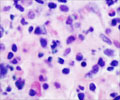Research has shown that the cells of human body have two major interconnected energy sources: the lipid metabolism and the glucose metabolism.

The current study used the clinically safe drug etomoxir to block prostate cancer cells' ability to oxidize lipids. With the lipid energy source removed, cells switched to glucose metabolism and both cells and mouse models roughly doubled their uptake of radiolabeled glucose.
"Because prostate cancer can be a slow-growing disease, instead of immediate treatment, many men choose active surveillance – they watch and wait. But that requires repeated prostate biopsies. Instead, now we could use this metabolic technique to allow PET imaging to monitor prostate cancer progression without the need for so many biopsies," says Schlaepfer.
Schlaepfer also points out possible therapeutic application of the technique: while immediately useful for imaging, it may be that cutting off a prostate cancer cell's ability to supply itself with energy from lipids could make it difficult for these cells to survive.
Source-Eurekalert

![Prostate Specific Antigen [PSA] & Prostate Cancer Diagnosis Prostate Specific Antigen [PSA] & Prostate Cancer Diagnosis](https://images.medindia.net/patientinfo/120_100/prostate-specific-antigen.jpg)












